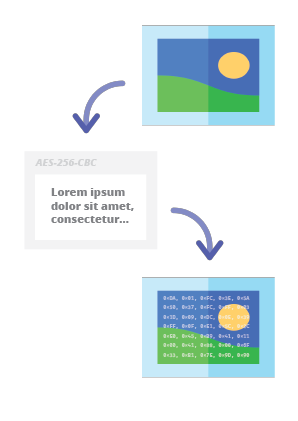Steganography Online Codec
Steganographic online codec allows you to hide a password encrypted message within the images & photos using AES encryption algorithm with a 256-bit PBKDF2 derived key.
What is steganography and how it works?
The art and science of hiding information by embedding messages within other, seemingly harmless image files.
In this case, the individual bits of the encrypted hidden message are saved as the least significant bits in the RGB color components in the pixels of the selected image.
With our steganographic encoder you will be able to conceal any text message in the image in a secure way and send it without raising any suspicion. It will only be possible to read the message after entering the decryption password.

Encode hidden message
Select input image PNG JPG GIF BMP
Decode hidden message
Select input image PNG
Security & Trust
| Features | |
|---|---|
| Strong cryptography used AES & PBKDF2 | |
| Stable & locked down method of encoding | |
| Trusted by a $20.000 crypto puzzle | |
| Usage statistics | Counter |
|---|---|
| Encodings | 31278 |
| Decodings | 33930 |
| Total | 65208 |
Video tutorial of how to hide a secret message in image
Frequently Asked Questions
What are the practical usages of steganography?
A few examples:
- You can store hidden and encrypted messages within images and transfer them to anyone via email without any suspicion
- Whistleblowing and undercover journalism
- Send secret messages in highly monitored or hostile environments (e.g. state monitored Internet, military operation areas)
- You can embed images with hidden messages on the web pages
How is the message stored within the image?
The following algorithm is used:
- Message string is compressed with DEFLATE algorithm to reduce its size
- Strong cryptographic key is generated from the provided password using PBKDF2 algorithm with 20000 iterations
- Compressed data is encrypted with the previously calculated key in CBC mode using 256 bit AES encryption
- Encrypted bits are embedded in least significant bits in the RGB color components in the pixels of the selected image
Is it secure against brute-force attacks?
It's very secure. You need an original password to read the message and thanks to PBKDF2 key derivation function with 20000 iterations brute force attacks are not practical.
Can I convert the image with the encoded hidden message to another format (e.g. JPG)?
Unfortunately, no. Only lossless image formats like PNG allow to save and recreate the encoded message in its original form. Any format that uses compression or even resizing of the image will result in the loss of some of the data needed to reproduce the original message.
I sent a photo through Facebook, but the hidden message was lost, why?
Unfortunately, sites such as Facebook use lossy compression before sending the photo, to reduce the size of the transmitted data, as a result of which the original encrypted message will be corrupted. To send an image with a hidden message through services like Facebook, first compress it into a ZIP or RAR archive and send the image in the archive file.
Are the modifications made to the image visible?
Modifications are not visible to the naked eye, because only the individual bits of the RGB color component of the individual pixels of the image are modified.
Got questions?
If you are interested in the Stenography Online Codec or have any questions about it or if something is not clear, please contact me. I'll be happy to answer all of your questions.